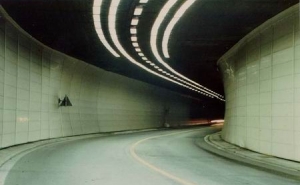You are here
Rehabilitation of Tunnels
Within the last 10 to 15 years, tunnel sealing (rehabilitation with cladding and installation of a waterproofing system) became a solid feature of tunneling in Europe. In other countries worldwide, e.g. U.S., Asia, etc., similar rehabilitation concepts have been applied since about 1985. A vast majority of older road tunnels show seriously damaged areas resulting from water leakage into the tunnel interior. A typical example is shown in Figure 1.
Leakage of tunnels can result in a hazardous impact on traffic due to:
- low visibility causing psychological stress;
- slippery road and danger of ice;
- occurrence of icicles (only in northern regions).
As a consequence, responsible owners have carried out many different rehabilitation attempts.
One of the most common attempts to seal such tunnels by using injections has failed due to reasons of physics. In most rehabilitation attempts these injections did more harm than good (drainage systems outside the tunnel lining were plugged up, which hampered the drainage of water and therefore led to the occurrence of additional water in the tunnel crown).
This brochure suggests a form of rehabilitation for tunnels where stability is usually not endangered by the infiltrating water which typically causes chemical and mechanical erosion of structural support members, e.g. reinforcing steel. By rehabilitating the tunnel, the above mentioned adverse impacts on tunnel traffic are significantly reduced or even eliminated. Simultaneously, the interior of the tunnel becomes easier to maintain and more appealing.
Directly where water leakage into the tunnel occurs, it is collected in drains. This is performed such that even at low temperatures no ice can build up. The tunnel wall is covered with thermal protection sheets which in addition prevents ice from forming.
Important features of this rehabilitation system are:
- drilling of relief holes to reduce water pressure within the surrounding strata;
- diversion drilling;
- PVC-membranes for collecting water, ending with a special clog-slot;
- thermal protection (water resistant);
- Colored interior sealing with either:
- metal sheets, or
- synthetic sheets, or
- other weather and abrasion resistant materials (see Figure 2).
It is necessary that the inner sealing (wall cladding with waterproofing system) can be easily applied, and easily replaced which might be required for example after traffic accidents, and only moderately reduces tunnel clearance. It also has to be washable and corrosion proof.
Two systems of applying the sealing have proven to be very effective:
- Horizontal sealing sheets (see Figure 3).
- Vertical (bent) sealing sheets, up to 1 m wide, on a horizontal wall element which is also 1 m high (see Figure 4).
While the horizontal version (Figure 3) is polygonal, the elements of the vertical version (Figure 4) are pre-bent according to the tunnel wall. The single sheets are filled with inflammable rock wool and thus are fire-resistant.




